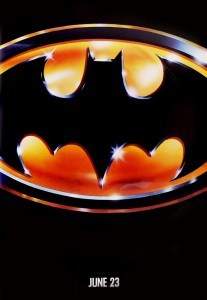 By strange coincidence, I rewatched the 1989 Batman film yesterday, with no idea that today was the film’s 25th anniversary.
By strange coincidence, I rewatched the 1989 Batman film yesterday, with no idea that today was the film’s 25th anniversary.
I don’t remember when I first saw Batman. I was only three in 1989, but looking back on my childhood, Batman was one of those movies that was always wonderfully there, and I saw it early enough that it’s always had a warm, Tim Burton-y place in my heart. (I do remember seeing Batman Returns in the theater, and loving it immediately, though my mother was appalled by its dark tone.) Like a lot of kids in the early 90s, I was hooked on Batman media: the two Tim Burton films, reruns of the 60s television series and film, and of course the legendary Batman: The Animated Series. If Batman was on screen, I was all over it, though it wouldn’t be until years later that I actively dove into the Batman comics. I was a pretty young kid, but wise enough to look at Jim Balent’s Catwoman and realize, “this is not for me.”
Michael Keaton is “my” Batman, and 25 years later I feel that his performance is somewhat overlooked, maybe because it’s neither the corny campiness of Adam West nor the gritty realism of Christian Bale. Like Edward Scissorhands or Lydia Deetz, Bruce Wayne is Tim Burton’s quintessential hero: the lonely weirdo in the old, dark house at the end of the street. Bruce is introverted and reclusive — his meet cute with Vicki Vale hinges on the fact that neither she nor her colleague, both journalists, know what Gotham City’s richest man looks like. His initial courtship with Vicki is awkward — that dinner scene! — and a far cry from Christian Bale Patrick Bateman-ing it up with a ballerina on each arm.
And then there’s the whole “sleeping upside down like a bat” thing. Burton understood that for Bruce Wayne to be Batman, and to do what Batman does every night, the guy has to be somewhat strange. Unfortunately when Keaton and Burton left the film series, Bruce lost that melancholy weirdness, and only the rich boy with snarky quips remained. (Can you imagine George Clooney’s smug-on-a-stick Bruce Wayne botching a date with Vicki Vale?)
Valid points have been made that Batman is really the Joker’s film — when one of two primary characters is loud, splashy, and colorful, and the other is none of those things, the one dancing to Prince songs is probably going to be the scene-stealer, even if he’s not Jack Nicholson. (There are multiple scenes of the Joker just fucking dancing along to Prince songs, and they are amazing.) The Batman scene most deeply etched into my mind is Joker’s museum “date” with Vicki Vale, which perfectly embodies the film’s “dark kitsch” tone. It’s very easy to be caught up in the energy of the scene, as Joker bounces through the museum, spray-painting priceless masterpieces while Prince’s “Partyman” blasts from his goons’ gigantic boom boxes. Then you remember that the Joker just gassed everyone in the museum, and forced Vicki to watch helplessly, and you remember what a monster he is.
http://youtu.be/rV63BVTv9gw
(Sorry, the only clip on Youtube with the Prince track intact is dubbed into French.)
Especially chilling is Joker’s misogyny. Vicki is the “Beauty” to his “Beast,” but he disfigures four other women, including his former girlfriend, as easily as he desecrates the museum’s paintings, as if Vicki is the only thing he can stand being beautiful in the world. I wish Kim Basinger was a stronger presence in this movie, but she feels like a weak, squeaky-voiced echo of Margot Kidder’s Lois Lane. Even with that oh-so-80s single Jedi braid in her hair, she’s ultimately forgettable. It’s unsurprising that, like one of James Bond’s interchangeable love interests, she disappears between sequels. (Michelle Pfeiffer’s Catwoman could not get here soon enough.)
Batman is ultimately a strange, otherworldly film. It’s a “comic book movie” in the best sense of the term. Gotham City is recognizable as a major, crime-infested city, but it’s somehow “off;” an art deco metropolis seen through a distorted mirror. It’s not our world, exactly, but it’s simultaneously darker and more colorful, and the only world Batman and the Joker could live in. Christopher Nolan’s Dark Knight Trilogy strove to make Batman’s universe as plausible and “realistic” as it could possibly be (with the exception of Heath Ledger’s Joker, who was like a nightmare assuming human form). Of course, that’s a perfectly valid artistic choice as well — what’s remarkable about Batman is that there’s room for an infinity of different interpretations of the character, and they’re all still somehow “Batman.” 1989’s Batman may no longer be the definitive screen version of Batman, but it’s my Batman, dammit.
“I don’t know if it’s art, but I like it!”

